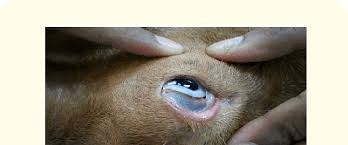Tetanus is a disease that causes stiffness that leads to paralysis and then death. Goats are very susceptible to tetanus. Tetanus is caused by a toxin produced by the bacterium Clostridium tetani. These bacteria live in the soil, in faeces and in dust on the goat’s skin. When a penetrating wound occurs, tetanus bacteria may multiply in the wound and produce a powerful toxin.
This fatal disease occurs as a result of a wound becoming infected by bacteria commonly found in soil and faeces.
There’s a reason tetanus is colloquially known as lockjaw: One of the final symptoms, is the inability to open the mouth. If you catch the symptoms early, it may be possible to save your goat through aggressive treatment — but most stricken caprines die. Fortunately, it’s easy to avoid tetanus by keeping your goats’ vaccinations up to date and thoroughly cleaning and disinfecting any wounds.

Infection of wounds by bacterium Clostridium tetani results in tetanus when the bacterium produces its potent toxin. Wounds can include those caused by humans when live tissues are injured and blood drawn during hoof trimming. The organism is sensitive to oxygen, so deep puncture wound are of the most concern.
Therefore, animals are at high risk when using the elastic band method of castration as this makes a wound.
The disease is preventable by using the appropriate vaccine at the right time or as recommended by an expert.
Symptoms, Prevention and Treatment of Tetanus Disease in Goats
Some of the basic signs and symptoms may include but not limited to the following:
Spots on the lungs showing pneumonia Live animal:
The symptoms include fever, lack of appetite, rapid breathing, coughing, loss of condition and discharge from the nose.
A multi-component vaccine can be used to prevent certain types of lung infections in sheep and goats.
Sick animals can be treated with an oxytetracycline antibiotic such as Terramycin or Hi-Tet.Hi-Tet 200 LA dosage: Intramuscular injection. 1ml/10kg live-mass. Repeat after 3 days if necessary.
Signs

Signs of illness can include muscle stiffness, unsteady gait, drooping eyelids, changed voice, erect ears and tail and inability to eat or drink. The signs often get progressively worse and convulsions may occur. Death occurs from asphyxiation secondary to respiratory paralysis.
Prevention
Prevention of this disease is much more effective and economical than treatment of affected goats. Annual vaccination is recommended for all goats for prevention.
Treatment
Treatment includes high doses of penicillin, anti-inflammatories and tetanus anti-toxin, but it often fails. The initial site of injury and bacterial proliferation should be searched for, and whenever is possible, the wound or infection site should be opened to the air and infiltrated with penicillin.
The area can be infiltrated with tetanus antitoxin before the wound-cleansing process is begun to reduce the chance that more preexisting toxin will be absorbed during tissue manipulation. Excessive tissue manipulation may make the animal dramatically worse.
Read Also: Strategies for Improving Cattle Production
Read Also: Complete List of Animals Feed Raw Materials and Their Uses
Read Also: 21 Amazing Importance of Water (H2O) to the Body
Read Also: 10 Amazing Health Benefits of Cucumber Fruit
Read Also: Recommended Equipment‘s and Tools Needed in Snail Farming Business
Read Also: Mechanism of Animal Body Defense against Stress
Read Also: 7 Amazing Health Benefits of Cherries
Read Also: 22 High Fiber Foods we have and their Contents
Read Also: 21 Amazing Nutritional and Health Benefits of Orange Juice

